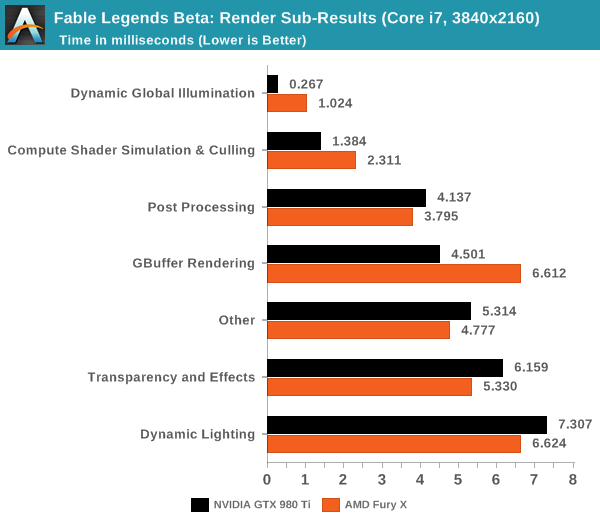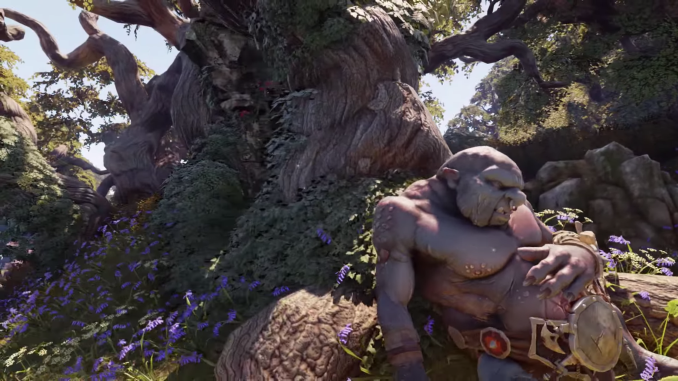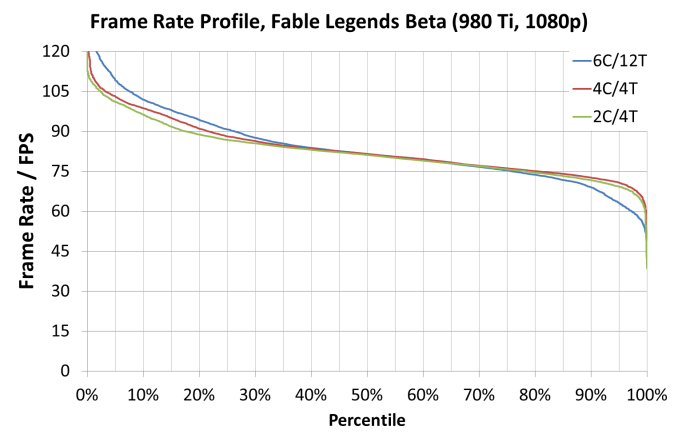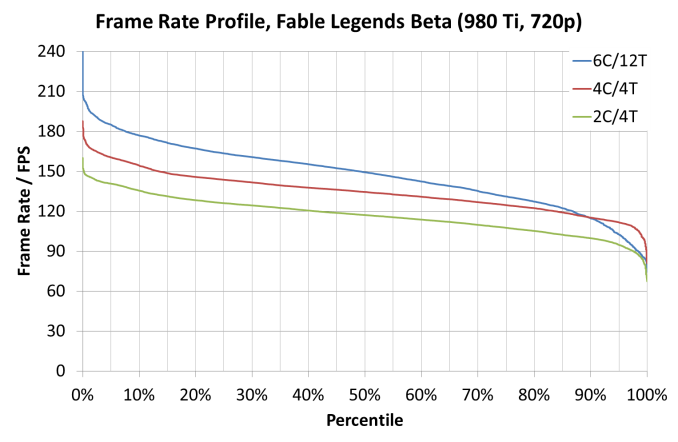Fable Legends Early Preview: DirectX 12 Benchmark Analysis
by Ryan Smith, Ian Cutress & Daniel Williams on September 24, 2015 9:00 AM ESTFinal Words
Non-final benchmarks are a tough element to define. On one hand, they do not show the full range of both performance and graphical enhancements and could be subject to critical rendering paths that cause performance issues. On the other side, they are near-final representations and aspirations of the game developers, with the game engine almost at the point of being comfortable. To say that a preview benchmark is somewhere from 50% to 90% representative of the final product is not much of a bold statement to make in these circumstances, but between those two numbers can be a world of difference.
Fable Legends, developed by Lionhead Studios and published by Microsoft, uses EPIC’s Unreal 4 engine. All the elements of that previous sentence have gravitas in the gaming industry: Fable is a well-known franchise, Lionhead is a successful game developer, Microsoft is Microsoft, and EPIC’s Unreal engines have powered triple-A gaming titles for the best part of two decades. With the right ingredients, therein lies the potential for that melt-in-the-mouth cake as long as the oven is set just right.
Convoluted cake metaphors aside, this article set out to test the new Fable Legends benchmark in DirectX 12. As it stands, the software build we received indicated that the benchmark and game is still in 'early access preview' mode, so improvements may happen down the line. Users are interested in how DX12 games will both perform and scale on different hardware and different settings, and we aimed to fill in some of those blanks today. We used several AMD and NVIDIA GPUs, mainly focusing on NVIDIA’s GTX 980 Ti and AMD’s Fury X, with Core i7-X (six cores with HyperThreading), Core i5 (quad core, no HT) and Core i3 (two cores, HT) system configurations. These two GPUs were also tested at 3840x2160 (4K) with Ultra settings, 1920x1080 with Ultra settings and 1280x720 with low settings.
On pure average frame rate numbers, we saw NVIDIA’s GTX 980 Ti by just under 10% in all configurations except for the 1280x720 settings which gave the Fury X a substantial (10%+ on i5 and i3) lead. Looking at CPU scaling, this showed that scaling only ever really occurred at the 1280x720 settings anyway, with both AMD and NVIDIA showing a 20-25% gain moving from a Core i3 to a Core i7. Some of the older cards showed a smaller 7% improvement over the same test.
Looking through the frame rate profile data, specifically looking for minimum benchmark percentile numbers, we saw an interesting correlation with using a Core i7 (six core, HT) platform and the frame rates on complex frames being beaten by the Core i5 and even the Core i3 setups, despite the fact that during the easier frames to compute the Core i7 performed better. In our graphs, it gave a tilted axis akin to a seesaw:
When comparing the separate compute profile time data provided by the benchmark, it showed that the Core i7 was taking longer for a few of the lighting techniques, perhaps relating to cache or scheduling issues either at the CPU end or the GPU end which was alleviated with fewer cores in the mix. This may come down to a memory controller not being bombarded with higher priority requests causing a shuffle in the data request queue.

When we do a direct comparison for AMD’s Fury X and NVIDIA’s GTX 980 Ti in the render sub-category results for 4K using a Core i7, both AMD and NVIDIA have their strong points in this benchmark. NVIDIA favors illumination, compute shader work and GBuffer rendering where AMD favors post processing, transparency and dynamic lighting.
DirectX 12 is coming in with new effects to make games look better with new features to allow developers to extract performance out of our hardware. Fable Legends uses EPIC’s Unreal Engine 4 with added effects and represents a multi-year effort to develop the engine around DX12's feature set and ultimately improve performance over DX11. With this benchmark we have begun to peek a little in to what actual graphics performance in games might be like, and if DX12 benefits users on low powered CPUs or high-end GPUs more. That being said, there is a good chance that the performance we’ve seen today will change by release due to driver updates and/or optimizing the game code. Nevertheless, at this point it does appear that a reasonably strong card such as the 290X or GTX 970 are needed to get a smooth 1080p experience (at Ultra settings) with this demo.














141 Comments
View All Comments
Nenad - Thursday, September 24, 2015 - link
I suggest using 2560x1440 as one of tested resolution for articles where important part are top cards, since that is currently sweet spot for top end cards like GTX 980Ti or AMD Fury.I know that, on steam survey, that resolution is not nearly represented as 1920x1080, but neither are cards like 980ti and FuryX.
Jtaylor1986 - Thursday, September 24, 2015 - link
The benchmark doesn't support this.Peichen - Thursday, September 24, 2015 - link
Buy a Fury X if you want to play Fable at 720p. Buy a 980Ti if you want to play 4K. And remember, get a fast Intel CPU if you are playing at 720p otherwise your Fury X won't be able to do 120+fps.DrKlahn - Thursday, September 24, 2015 - link
The Fury is 2fps less at 4k (though a heavily overclocked 980ti may increase this lead), so I'd say both are pretty comparable at 4K. Fury also scales better at lower resolutions with lower end CPU's so I'm not sure what point you're trying to make. Although to be fair none of the cards tested struggle to maintain playable frame rates at lower resolutions.Asomething - Thursday, September 24, 2015 - link
Man what a strange world where amd has less driver overhead than the competition.extide - Thursday, September 24, 2015 - link
Also, remember there are those newer AMD drivers that were not able to be used for this test. I could easily see a new driver gaining 2+ fps to match/beat the 980 ti in this game.Gigaplex - Thursday, September 24, 2015 - link
If you're buying a card specifically for one game at 720p, you wouldn't be spending top dollar for a Fury X.Jtaylor1986 - Thursday, September 24, 2015 - link
Kind of suprising you chose to publish this at all. Given how limited the testing options are in the benchmark this release seems a little to much like a pure marketing stunt for my tastes from Lionhead and Microsoft rather than a DX12 showcase. The fact that it doesn't include a DX11 option is a dead giveaway.piiman - Saturday, September 26, 2015 - link
"The fact that it doesn't include a DX11 option is a dead giveaway."My thought also. What the point of this Benchmark if there are no Dx11 to compare them to?
Gotpaidmuch - Thursday, September 24, 2015 - link
How come GTX 980 was not included in the tests? Did it score that bad?